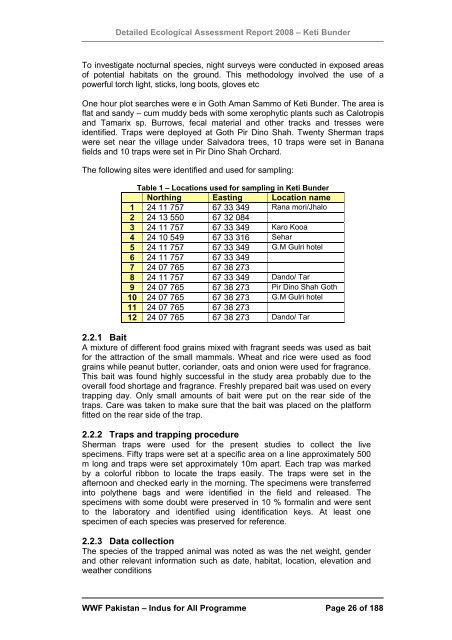Disclaimer note - WWF - Pakistan
Disclaimer note - WWF - Pakistan
Disclaimer note - WWF - Pakistan
Create successful ePaper yourself
Turn your PDF publications into a flip-book with our unique Google optimized e-Paper software.
Detailed Ecological Assessment Report 2008 – Keti Bunder<br />
To investigate nocturnal species, night surveys were conducted in exposed areas<br />
of potential habitats on the ground. This methodology involved the use of a<br />
powerful torch light, sticks, long boots, gloves etc<br />
One hour plot searches were e in Goth Aman Sammo of Keti Bunder. The area is<br />
flat and sandy – cum muddy beds with some xerophytic plants such as Calotropis<br />
and Tamarix sp. Burrows, fecal material and other tracks and tresses were<br />
identified. Traps were deployed at Goth Pir Dino Shah. Twenty Sherman traps<br />
were set near the village under Salvadora trees, 10 traps were set in Banana<br />
fields and 10 traps were set in Pir Dino Shah Orchard.<br />
The following sites were identified and used for sampling:<br />
Table 1 – Locations used for sampling in Keti Bunder<br />
Northing Easting Location name<br />
1 24 11 757 67 33 349 Rana mori/Jhalo<br />
2 24 13 550 67 32 084<br />
3 24 11 757 67 33 349 Karo Kooa<br />
4 24 10 549 67 33 316 Sehar<br />
5 24 11 757 67 33 349 G.M Gulri hotel<br />
6 24 11 757 67 33 349<br />
7 24 07 765 67 38 273<br />
8 24 11 757 67 33 349 Dando/ Tar<br />
9 24 07 765 67 38 273 Pir Dino Shah Goth<br />
10 24 07 765 67 38 273 G.M Gulri hotel<br />
11 24 07 765 67 38 273<br />
12 24 07 765 67 38 273 Dando/ Tar<br />
2.2.1 Bait<br />
A mixture of different food grains mixed with fragrant seeds was used as bait<br />
for the attraction of the small mammals. Wheat and rice were used as food<br />
grains while peanut butter, coriander, oats and onion were used for fragrance.<br />
This bait was found highly successful in the study area probably due to the<br />
overall food shortage and fragrance. Freshly prepared bait was used on every<br />
trapping day. Only small amounts of bait were put on the rear side of the<br />
traps. Care was taken to make sure that the bait was placed on the platform<br />
fitted on the rear side of the trap.<br />
2.2.2 Traps and trapping procedure<br />
Sherman traps were used for the present studies to collect the live<br />
specimens. Fifty traps were set at a specific area on a line approximately 500<br />
m long and traps were set approximately 10m apart. Each trap was marked<br />
by a colorful ribbon to locate the traps easily. The traps were set in the<br />
afternoon and checked early in the morning. The specimens were transferred<br />
into polythene bags and were identified in the field and released. The<br />
specimens with some doubt were preserved in 10 % formalin and were sent<br />
to the laboratory and identified using identification keys. At least one<br />
specimen of each species was preserved for reference.<br />
2.2.3 Data collection<br />
The species of the trapped animal was <strong>note</strong>d as was the net weight, gender<br />
and other relevant information such as date, habitat, location, elevation and<br />
weather conditions<br />
<strong>WWF</strong> <strong>Pakistan</strong> – Indus for All Programme Page 26 of 188

















